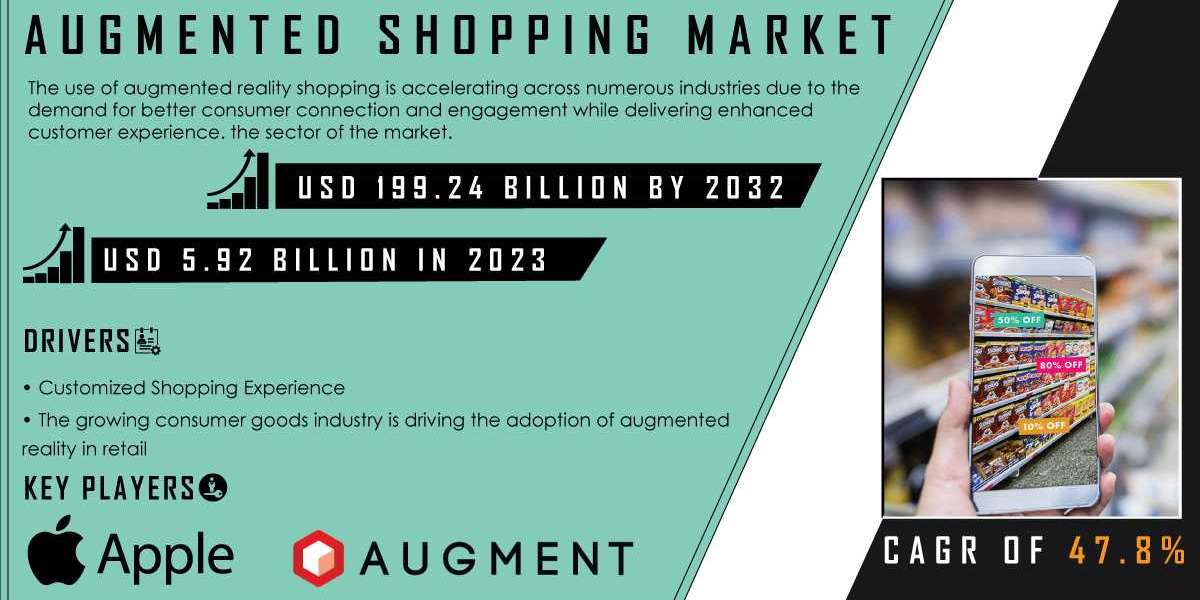Augmented Shopping 2024
In an era where technology continuously reshapes consumer behavior, augmented shopping emerges as a significant innovation that transforms how people engage with retail environments. Blending digital elements with the physical shopping experience, augmented shopping enhances consumer interactions through immersive technologies like augmented reality (AR) and virtual reality (VR). As retailers recognize the potential of these technologies to improve customer engagement and satisfaction, the Augmented Shopping Market Share reflects a burgeoning interest in solutions that merge the physical and digital worlds. The Augmented Shopping Market size was USD 5.92 billion in 2023 and is expected to reach USD 199.24 billion by 2032, growing at a CAGR of 47.8% over the forecast period of 2024-2032. This remarkable growth indicates a pivotal shift in how consumers shop, fostering a more interactive and personalized retail experience.
The Concept of Augmented Shopping
Augmented shopping involves overlaying digital information onto the physical shopping experience, allowing consumers to interact with products in innovative ways. This concept transcends traditional retail by integrating digital features that enhance product discovery, evaluation, and purchasing processes. By utilizing smartphones, tablets, or AR glasses, consumers can visualize products in their real-world context, facilitating informed purchasing decisions.
This interactive shopping experience caters to the evolving expectations of tech-savvy consumers who seek convenience, personalization, and engagement in their shopping journeys. As digital natives increasingly dominate the consumer landscape, businesses are compelled to adapt their strategies to align with these preferences.
Enhancing Customer Experience
One of the primary benefits of augmented shopping is its ability to elevate the customer experience. By incorporating AR features into mobile applications and in-store displays, retailers can create an immersive environment that captivates consumers. For instance, customers can use their smartphones to scan a product label, triggering a 3D model that displays detailed information, customer reviews, and related products. This instant access to information empowers consumers to make informed choices without feeling overwhelmed.
In addition to product information, augmented shopping allows customers to visualize how products fit into their lives. For instance, furniture retailers can offer AR applications that enable consumers to see how a sofa would look in their living room. By simply pointing their device at the space, customers can view a virtual representation of the product, helping them envision how it integrates with their existing decor. This capability reduces the uncertainty associated with online shopping, ultimately enhancing customer confidence and satisfaction.
Bridging the Online and Offline Gap
Augmented shopping is particularly effective in bridging the gap between online and offline shopping experiences. With the rise of e-commerce, consumers often struggle to replicate the tactile experience of shopping in physical stores. Augmented shopping addresses this challenge by merging the advantages of both channels.
For example, retailers can enhance their brick-and-mortar stores with interactive displays that provide product information, promotions, and personalized recommendations through AR. Customers can scan QR codes or use in-store apps to access exclusive content and discounts, encouraging them to engage with the brand. This hybrid approach not only attracts foot traffic to physical locations but also fosters loyalty among consumers who appreciate a seamless shopping experience.
Personalization and Targeted Marketing
Another significant advantage of augmented shopping lies in its potential for personalization. By leveraging consumer data and preferences, retailers can tailor augmented experiences to meet individual needs. For instance, a beauty retailer could utilize AR to allow customers to try on makeup virtually. By scanning their faces, customers can experiment with different shades and styles, receiving personalized product recommendations based on their skin tone and preferences.
Targeted marketing also becomes more effective through augmented shopping. Retailers can analyze consumer behavior to deliver relevant offers and promotions in real time. For instance, if a customer frequently purchases sports apparel, an AR application could highlight related products, discounts, or upcoming events that match their interests. This personalized approach not only increases customer engagement but also drives sales by presenting consumers with products they are likely to purchase.
Driving Engagement Through Gamification
Gamification is another powerful element of augmented shopping that enhances customer engagement. By incorporating game-like features into the shopping experience, retailers can create a fun and interactive environment that encourages exploration. For example, brands can design AR scavenger hunts that guide customers through the store, unlocking discounts or rewards as they interact with various products.
This gamified approach fosters a sense of community among consumers, as they share their experiences on social media and invite friends to participate. By transforming shopping into a game, retailers not only capture attention but also enhance brand loyalty among consumers who enjoy the immersive experience.
Challenges and Considerations
While the potential of augmented shopping is substantial, retailers must also navigate several challenges. One of the primary concerns is the accessibility of AR technology. Although smartphone penetration is high, not all consumers are familiar with or comfortable using AR applications. Retailers need to consider user-friendly designs and provide adequate support to ensure a smooth experience for all customers.
Data privacy and security are also paramount. As retailers collect and analyze consumer data to enhance personalized experiences, they must implement robust measures to protect sensitive information. Establishing transparent data practices and adhering to regulations will be crucial in maintaining customer trust.
Additionally, the cost of implementing augmented shopping solutions can be a barrier for some retailers. Developing AR applications and integrating them into existing systems requires investment in technology and resources. Small and medium-sized enterprises may need to explore partnerships or seek affordable solutions to leverage augmented shopping effectively.
Future Trends in Augmented Shopping
As technology continues to advance, several trends are likely to shape the future of augmented shopping. The integration of artificial intelligence (AI) with AR will enhance personalization and product recommendations. AI algorithms can analyze consumer behavior, preferences, and purchase history to deliver tailored experiences that resonate with individual customers.
Moreover, the rise of 5G technology will improve the performance of AR applications, enabling seamless interactions and real-time updates. Faster connectivity will reduce latency, enhancing the overall user experience and making augmented shopping more accessible to a broader audience.
Sustainability is also becoming a key consideration in retail, and augmented shopping can contribute to eco-friendly practices. By allowing customers to visualize products virtually, retailers can reduce returns and minimize waste associated with unsold inventory. This environmentally conscious approach aligns with the growing demand for sustainable practices among consumers.
Conclusion
Augmented shopping represents a transformative evolution in the retail landscape, enabling businesses to engage customers in innovative and meaningful ways. By blending digital and physical experiences, retailers can enhance customer satisfaction, drive sales, and foster brand loyalty. As the Augmented Shopping Market continues to grow, businesses must embrace the opportunities presented by this technology while addressing challenges related to accessibility, privacy, and implementation.
The future of augmented shopping holds immense potential, driven by advancements in technology and evolving consumer expectations. Retailers that prioritize immersive experiences, personalization, and community engagement will be well-positioned to thrive in this dynamic landscape. As augmented shopping becomes more mainstream, it will redefine how consumers interact with brands, shaping the future of retail for years to come.
Contact Us:
Akash Anand – Head of Business Development Strategy
info@snsinsider.com
Phone: +1-415-230-0044 (US) | +91-7798602273 (IND)
About Us
SNS Insider is one of the leading market research and consulting agencies that dominates the market research industry globally. Our company's aim is to give clients the knowledge they require in order to function in changing circumstances. In order to give you current, accurate market data, consumer insights, and opinions so that you can make decisions with confidence, we employ a variety of techniques, including surveys, video talks, and focus groups around the world.
Read Our Other Reports:
Insurance Telematics Market Share













